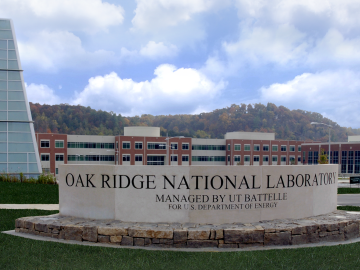
Filter News
Area of Research
- Advanced Manufacturing (4)
- Building Technologies (1)
- Chemical and Engineering Materials (1)
- Clean Energy (31)
- Climate and Environmental Systems (1)
- Computational Engineering (1)
- Computer Science (6)
- Fusion Energy (4)
- Materials (18)
- National Security (2)
- Neutron Data Analysis and Visualization (2)
- Neutron Science (11)
- Nuclear Science and Technology (9)
- Quantum information Science (2)
- Supercomputing (14)
- Transportation Systems (1)
News Type
Date
News Topics
- 3-D Printing/Advanced Manufacturing (6)
- Advanced Reactors (5)
- Artificial Intelligence (5)
- Big Data (5)
- Biomedical (1)
- Clean Water (2)
- Composites (1)
- Computer Science (15)
- Cybersecurity (1)
- Energy Storage (4)
- Environment (6)
- Fusion (3)
- Grid (3)
- Machine Learning (3)
- Materials Science (9)
- Microscopy (2)
- Molten Salt (1)
- Nanotechnology (2)
- Neutron Science (8)
- Nuclear Energy (9)
- Physics (2)
- Polymers (1)
- Quantum Science (3)
- Space Exploration (3)
- Summit (2)
- Sustainable Energy (2)
- Transportation (7)
Media Contacts



A ground source heat pump installed at rural Cedarville High School in Arkansas through the American Recovery and Reinvestment Act has reduced energy use by 53 percent and carbon dioxide emissions by 52 percent, according to an Oak Ridge National Laboratory report. ORNL researchers X...

While reflective roofs can save energy and money for homeowners, microbial communities and the biofilms they create can eat away at the effectiveness and savings. A study led by Mengdawn Cheng and Andre Desjarlais of Oak Ridge National Laboratory found that the amount of energy absor...


Designers of safe high-performance batteries for electric vehicles are getting a hand with a new computational toolset created by a team led by Sreekanth Pannala and John Turner of Oak Ridge National Laboratory. The software simulates key battery performance indicators, including cha...



Hundreds of the nation’s premier cyberspace researchers will gather at Oak Ridge National Laboratory April 7-9 to participate in the 10th Annual Cyber and Information Security Research Conference. The event will bring together cyber security researchers, program managers, decision m...



